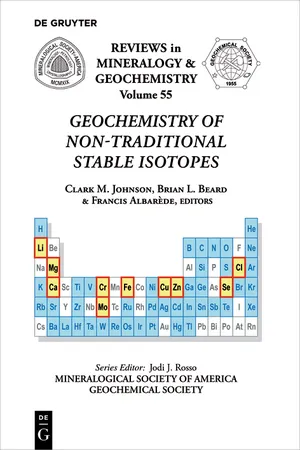
Geochemistry of Non-Traditional Stable Isotopes
- 470 pages
- English
- PDF
- Available on iOS & Android
Geochemistry of Non-Traditional Stable Isotopes
About This Book
The goal for Volume 55 of Reviews in Mineralogy and Geochemistry was to bring together a summary of the isotope geochemistry of non-traditional stable isotope systems as is known through 2003 for those elements that have been studied in some detail, and which have a variety of geochemical properties. In addition, recognizing that many of these elements are of interest to workers who are outside the traditional stable isotope fields, we felt it was important to include discussions on the broad isotopic variations that occur in the solar system, theoretical approaches to calculating isotopic fractionations, and the variety of analytical methods that are in use. We hope, therefore, that this volume proves to be useful to not only the isotope specialist, but to others who are interested in the contributions that these non-traditional stable isotopes may make toward understanding geochemical and biological cycles. The review chapters in this volume were the basis for a two-day short course on nontraditional stable isotopes held prior (May 15-16, 2004) to the spring AGU/CGU Meeting in Montreal, Canada.
Frequently asked questions
Information
Table of contents
- DEDICATION
- FOREWORD
- PREFACE & ACKNOWLEDGMENTS
- TABLE OF CONTENTS
- 1. Overview and General Concepts
- 2. An Overview of Isotopic Anomalies in Extraterrestrial Materials and Their Nucleosynthetic Heritage
- 3. Applying Stable Isotope Fractionation Theory to New Systems
- 4. Analytical Methods for Non-Traditional Isotopes
- 5. Developments in the Understanding and Application of Lithium Isotopes in the Earth and Planetary Sciences
- 6. The Isotope Geochemistry and Cosmochemistry of Magnesium
- 7. The Stable-Chlorine Isotope Compositions of Natural and Anthropogenic Materials
- 8. Calcium Isotopic Variations Produced by Biological, Kinetic, Radiogenic and Nucleosynthetic Processes
- 9. Mass-Dependent Fractionation of Selenium and Chromium Isotopes in Low-Temperature Environments
- 10A. Fe Isotope Variations in the Modern and Ancient Earth and Other Planetary Bodies
- 10B. Isotopic Constraints on Biogeochemical Cycling of Fe
- 11. The Stable Isotope Geochemistry of Copper and Zinc
- 12. Molybdenum Stable Isotopes: Observations, Interpretations and Directions